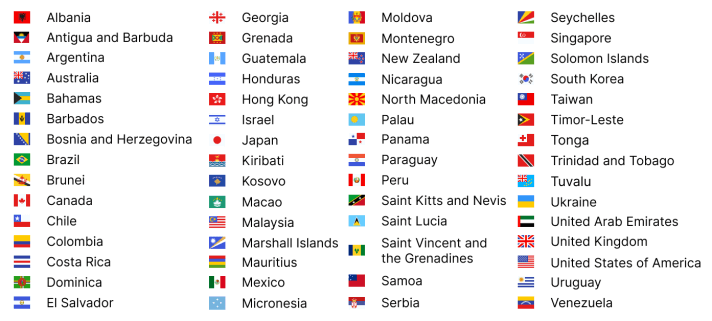New EU ETIAS System obliges visitors from visa-free countries to get a prior travel authorization to enter the EU.
When will ETIAS be implemented? Starting from the first half of 2025 citizens of the below countries that up until now did not require a visa to enter the Schengen area as tourists, will be required to apply for a travel authorization before their travel:

These rules come into effect with the new ETIAS system of the EU.

What is ETIAS?
If you are wondering what is an ETIAS travel authorization, note that by the 2025, the EU intends to strengthen its travel restrictions even more. It introduces a new system called the European Travel Information and Authorization System (ETIAS).
Persons visiting any of the European countries included in the program must apply for the new travel authorization system in advance of their trip (known as the ETIAS Authorization application). Since Ireland is a member of the Common Travel Area, it is exempt.
When will ETIAS be implemented? The current ETA program in the UK and the ESTA program in the USA are comparable to the idea behind the ETIAS. Although the ETIAS launch date is scheduled to become operational by the middle of 2025, the precise date of its implementation remains unknown.
This indicates that you do not currently require an ETIAS visa waiver to travel to Europe, and since the website is not operational and the system is not active, you are unable to obtain an official ETIAS at this time. Avoid any websites that purport to provide this service as they are not authorised and should be avoided.
Travellers from third countries that are exempt from requiring a visa must apply for ETIAS, which is expected to cost €7 when it becomes official. It is anticipated that the processing period will take 30 to 96 hours.
Put simply, this implies that you will require an ETIAS if you are not a citizen of an EU or Schengen nation and are visiting the EU for a brief period.
In line with the EES, a “short stay” is defined as a visit, vacation, or business trip lasting up to 90 days that takes place within a 180-day window.
An ETIAS application is not required if you are travelling with a valid visa or if you have an EU residency.
Applying for ETIAS is straightforward, but there are a few key steps you’ll need to follow to make sure your trip goes smoothly.
Step-by-Step Application for ETIAS
Step 1: Head to the ETIAS Website
First, you will need to access the ETIAS application page. This can be found on the European Union’s official travel website here. The form is entirely online, so visiting any consulate or embassy is unnecessary.
Step 2: Check Your Eligibility
Everyone will not be required to apply for ETIAS, so confirm if it applies to you. If you’re from a country currently visa-exempt for travel to the Schengen Area (like the US, Canada, Australia, and many others), ETIAS will be required. If you are unsure if it is needed for your country refer to the picture above of visa-exempt countries.
If your country of citizenship is on the list of countries that require a visa to enter the EU, you must still apply for the entry visa and ETIAS is not for you.
Step 3: Fill Out the Application
Once you have assured you need ETIAS, you will need to fill out the application which should only take ten minutes. You will need to provide the following information:
- Personal details: Full Legal Name, Date of Birth, and Nationality
- Passport Information: Passport number, date of issue, and expiration date
- Contact Information: Email address and Phone number
- Travel Details: The first Schengen country you will visit
- Security questions: Criminal history, prior travel to war zones, and if you have ever been deported or denied entry to another country
Step 4: Pay the Application Fee
The ETIAS Visa Application fee is €7 for applicants 18-79 years of age. Applicants outside of this age range will not have to pay but will have to fill out an application.
Step 5: Submit Your Application
Once you have double-checked your application and paid the fee, you are ready to submit. Most applicants will be processed within minutes. However, some special cases could take up to 30 days if additional checks are required. Ensure you apply at least 72 hours before your trip.
Step 6: Wait for Confirmation
After submission, you should receive a confirmation email concerning the status of your ETIAS application. Once it is approved the authorisation is electronically linked to your passport, no paperwork is required.
If your application is denied, do not panic, the email will explain why and you will be given information on how to appeal.
Step 7: Travelling with ETIAS
Once your ETIAS is approved, you are set to travel! It is valid for three years or until your passport expires, whichever is first. During this period you can make multiple trips to the Schengen area provided they do not exceed 90 days within 180 days.
Remember ETIAS is linked with your passport, so if your passport expires or gets lost or stolen, you will need to apply for a new ETIAS.
Applying for ETIAS is a vital step for travellers from visa-exempt countries preparing to visit the Schengen Area. Make sure to follow the steps above, and you’ll be ready for your European adventure in no time!
Nationals of the United Kingdom Applying for ETIAS
When does ETIAS start for the UK? Before Brexit, UK nationals could travel freely within the EU and the Schengen Area without needing any kind of authorisation. After Brexit, they now have to apply for ETIAS for short stays, similar to citizens of non-EU, visa-exempt countries.
For other citizens, ETIAS doesn’t mean a major change in travel procedures, as many were used to pre-travel authorisations or visas when visiting certain countries.
The ETIAS requirements for UK nationals in comparison to other citizens of visa-exempt countries are the same, thus the overall process is essentially the same.
UK nationals and their family members who are beneficiaries of the Withdrawal Agreement are exempt from ETIAS requirements. They are allowed to live in their EU host country and can travel to other European countries that typically require ETIAS, provided they carry documents that verify their Withdrawal Agreement beneficiary’s status in the EU.
For more information on the rules for UK citizens travelling to Spain, please see this article.
Other Categories of Travellers Who Need an ETIAS Travel Authorisation
ETIAS for nationals of visa-required countries
In special circumstances, nationals of countries that usually would require a visa to enter the Schengen Area may be able to travel with an ETIAS travel authorization instead. Below are the conditions when this may apply.
Students on School trips: If you are a student who is a national of a visa-required country but currently reside in a country that is a part of the ETIAS system, you may qualify for ETIAS while on a school trip:
- You must be travelling with a school group
- The trip has to be under the supervision of a teacher
- You must be exempt from needing a visa to enter all the ETIAS-requiring European countries on your itinerary
If you meet these criteria, you will not need a visa, just an ETIAS travel authorisation.
Refugees: If you are a recognized refugee in one of the countries participating in ETIAS or Ireland and carry a travel document issued by that country, you may be allowed to apply for ETIAS, provided you are visa-exempt for the countries you plan to visit.
- You must be a recognized refugee and hold a valid travel document
- Confirm that you do not require a visa for any of the Schengen countries on your itinerary
If you fulfil these conditions, you may travel with an ETIAS authorisation instead of a visa.
ETIAS for stateless persons
If you are a stateless person living in a country participating in the ETIAS system or Ireland and hold a travel document issued by one of these countries, you could also qualify for ETIAS if you are visa-exempt for your intended destination.
- You must reside in a country participating in the ETIAS program and hold a stateless person’s travel document.
- You need to verify that you are exempt from visa requirements for the countries you’re visiting.
If these conditions apply, you will only need ETIAS, not a visa.
For students, recognized refugees, and stateless persons from visa-required countries, ETIAS provides an accessible alternative to traditional visa processes. Nevertheless, eligibility is based on specific conditions, and it’s imperative to confirm your status with the consulates of the countries you’re visiting when ETIAS starts.
Who does not need an ETIAS Authorisation?
While ETIAS will soon be required for travellers from visa-exempt countries, several categories of people are exempt from needing this travel authorisation. Below is a breakdown of who won’t need to apply for ETIAS when travelling to Europe.
Nationals Within the Schengen Area: if you are a citizen of a country in the Schengen area which is enforcing ETIAS themselves, you will not have to apply for it. Your nationality already grants you the right to travel freely within the Schengen Area without this additional authorisation.
Nationals of Visa-Required Countries: if you come from a country where a visa is normally required to travel to the Schengen Area, you will have to apply for a visa as usual. However, some nationals from these countries may qualify for visa exemptions. If this applies to you, ETIAS may become necessary. Be sure to check the specific requirements for your country.
UK Nationals Benefiting from the Withdrawal Agreement: UK nationals and their family members who are beneficiaries of the Withdrawal Agreement do not need ETIAS. See more on how ETIAS will affect UK nationals above.
Nationals of Andorra, San Marino, Monaco, the Holy See, or Ireland: citizens of these countries are exempt from needing ETIAS when travelling to European countries that need it.
Refugees, Stateless Persons, or Persons Without Nationality: if you fall under one of these categories and reside in one of the European countries requiring ETIAS, and you have a travel document issued by that country, you will not need ETIAS.
Holders of Residence Permits or Residence Cards: if you have either of these issued by any of the countries requiring ETIAS, you are exempt.
Holders of Uniform Visas or National Long-Stay Visas: you are exempt from needing ETIAS. These visas already allow entry into the Schengen Area or the specific EU country for the duration specified.
Holders of Diplomatic, Service, or Special Passports: if you hold one of these you may not need ETIAS or a visa thanks to international agreements with the EU. This exemption applies to nationals from countries such as:
- Armenia, Azerbaijan, China (diplomatic passports only)
- Cape Verde (diplomatic and service/official passports)
- Belarus (diplomatic biometric passports)
Other nationals with similar passports may be exempt from ETIAS but still might need a visa. Always check with consulates before you travel to verify your status.
NATO and Partnership for Peace Business Travelers: Members of the armed forces travelling on NATO or Partnership for Peace business, and holding an identification and movement order under the NATO Status of Forces Agreement, are also exempt from needing ETIAS. However, if you’re travelling for private reasons during your trip, you must apply for ETIAS or a visa.
Intra-Corporate Transferees, Students, or Researchers: if you fall into one of these categories and exercise your right to mobility, you do not need to apply for ETIAS. Their status allows them to move between participating countries without this additional documentation.
Crew Members: When Do You Need an ETIAS Travel Authorisation?
If you are a crew member, you may require an ETIAS travel authorisation depending on your role and destination.
Civilian Air or Sea Crew Member on Duty: if you fall into this category, ETIAS requirements will depend on the European country you are travelling to. You must check the specific requirements based on your destination as each country has its own rules.
Civilian Sea Crew Member with a Seafarer’s Identity Document: the ETIAS requirements may differ depending on the country. Ensure to verify the rules for sea crew members in the countries you’re visiting before your trip.
Crew Members of Emergency or Rescue Missions: If you are part of an emergency or rescue mission, such as a disaster response team, police, or fire brigade, your entry and exit conditions are determined by national laws of the ETIAS-requiring countries. Some countries may have bilateral agreements for emergency service members.
Civilian Crew Member of Ships Navigating International Inland Waters: if you are a crew member navigating international inland waterways, the ETIAS requirements will also vary by country. Therefore, it is again important to check the specific entry requirements for crew members in the countries you plan to visit.
Frequently Asked Questions about ETIAS
If you have further questions regarding ETIAS travel authorisation you’re not alone. To help clarify what ETIAS entails and how it works, here is a link to the official website concerning frequently asked questions.
You’ll find detailed information about key topics such as what ETIAS is, how to apply, third-party application support, and the process for updating your information.
It also covers exemptions, fees, travel guidelines, and what happens in cases of refusal, cancellation, or appeals. Lastly, it delves into important details about the validity, renewal, and security aspects of ETIAS to ensure you’re fully prepared for your journey.
If you require professional advice on any related immigration procedure, get in contact through the form below, or our contact page, or call us so we can assist you with your matter.
This article is written in collaboration with Julia Gateman, a member of the Legal Support Team at Klev&Vera.




